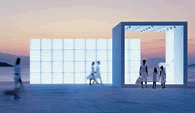Photopic Adaptation
This adaptation is important because not only does the eye discriminate between different wavelengths of light with the sensation of colour, but it is also more sensitive to some wavelengths than others, and this sensitivity alters between Photopic and Scotopic Vision.
For Photopic vision, the eye has a peak sensitivity at 555 nanometres, which is a yellow-green colour.
However, for Scotopic vision, peak sensitivity moves to 505 nanometres which is blue-green light, although the vision is in terms of black and white.
Scotopic Adaptation
In lighting science we are mostly concerned with Photopic vision and therefore it is the most important.
But we have a slight problem in that not every individual has exactly the same sensitivity. So the CIE, an international lighting body, has adopted an internationally agreed standard response called 'CIE standard observer’.
It is known as the V() curve and is a standard sensitivity for the eye across the spectrum of wavelengths from 380 to 760 nanometres. At 555 nanometres the sensitivity is at its highest, whereas at 400 nanometres, the sensitivity is only about one thousandth of the highest level. This means that one watt of radiation in the yellow-green part of the spectrum is 1000 times more effective than one watt of radiation in the deep blue part.
Units of Light
It is impractical to use the watt as a measure of light because of the variation in sensitivity of the eye with wavelength.
Instead we use the Lumen which is measurement of the rate of flow of the luminous energy, or the luminous flux at it is more often called. One lumen of luminous flux at 555 nanometres corresponds to a radiated power of 1/680th of a watt, but at 400 nanometres, 3.5 watts of radiated power equal to one lumen.
The relationship between the watt and the lumen is important as it is possible to calculate the luminous flux a particular lamp will produce by considering the radiated power at each wavelength and the corresponding eye sensitivity (as defined by the CIE) at that wavelength.
Visual Acuity
The eye is able to function across a very wide range of illuminance:
- Bright sunlight - 100,000 lux
- Street lighting - 5 lux
- Starlight - 0.2 lux
The eye does not operate well at every level of illuminance. For instance, illuminance has a direct bearing on the eye’s visual acuity, that’s the ability to see small detail.
In general, the more light there is, the better the eye sees, but the law of diminishing returns applies, so that increasing luminance beyond a certain point does not result in increased acuity.
Size and Contrast
Acuity will also be affected by the size of the object and the contrast. We can plot the effect of the factors on the visual performance of the eye under varying conditions of illuminance.
In the design of lighting, these relative visual performances have to be considered closely in order to produce the best level of illuminance for a specific function.
For example, in an office corridor where we only have to see things of large size with comparatively high contrast, then we can make do with low illuminance.
Whereas in situations of fine detail, poor contrast, or a combination of both, such as an operating theatre, watchmaker’s bench or micro-electronics assembly area, high illuminance is essential to ensure the best visual performance and minimise fatigue.
Adaptation
Adaptation is the process which takes place as the eye adjusts to the brightness of the colour of the visual field.
The term is also used, usually qualified, to denote the final state of the process. For example, 'dark adaptation’ denotes the state of the eye when it has become adapted to very low illuminance. Like somebody watching a film in a cinema.
The adaptation level is the level at which the eye will become adjusted in the steady state in a given visual environment. For the purpose of lighting calculations, the level is taken arbitrarily as the arithmetic average of the luminance of the visual field for a given direction of view. |



